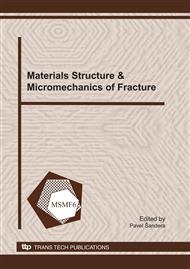[1]
K. J. Miller, The behaviour of short fatigue cracks and their initiation part II - a general summary Fatigue Fract Engng Mater Struct, 1987. 10 pp.93-113.
DOI: 10.1111/j.1460-2695.1987.tb01153.x
Google Scholar
[2]
T. Zhai; A. J. Wilkinson; J. W. Martin, A crystallographic mechanism for fatigue crack propagation through grain boundaries Acta Materialia 2000. 48: p.4917.
DOI: 10.1016/s1359-6454(00)00214-7
Google Scholar
[3]
S. Al-Shahrani; T. J. Marrow. Effect of surface finish on fatigue of stainless steels. in 12th International Conference of Fracture, ICF12. July 2009. Ottawa, CANADA.
Google Scholar
[4]
S. Al-Shahrani, Effect of surface finish on fatigue of austenitic stainless steels. 2010, PhD Thesis, The University of Manchester.
Google Scholar
[5]
Yung; Li; Lee; P. Jwo; H. Richard; B. Mark, Fatigue Testing and Analysis theory and Practice 2005: Ed. Elsevier Inc.
Google Scholar
[6]
B. D. Cullity; S.R. Stock, Elements of X-Ray Diffraction. Third Edition ed. (2001).
Google Scholar
[7]
V. Randle and O. Engler, Introduction to Texture Analysis: Macrotexture, Microtexture and Orientation Mapping. (2000).
DOI: 10.1201/9781482287479
Google Scholar
[8]
F.P.E. Dunne, A.J.W., R. Allen., Experimental and computational studies of low cycle fatigue crack nucleation in a polycrystal. International Journal of Plasticity 2007. 23 p.273–295.
DOI: 10.1016/j.ijplas.2006.07.001
Google Scholar


